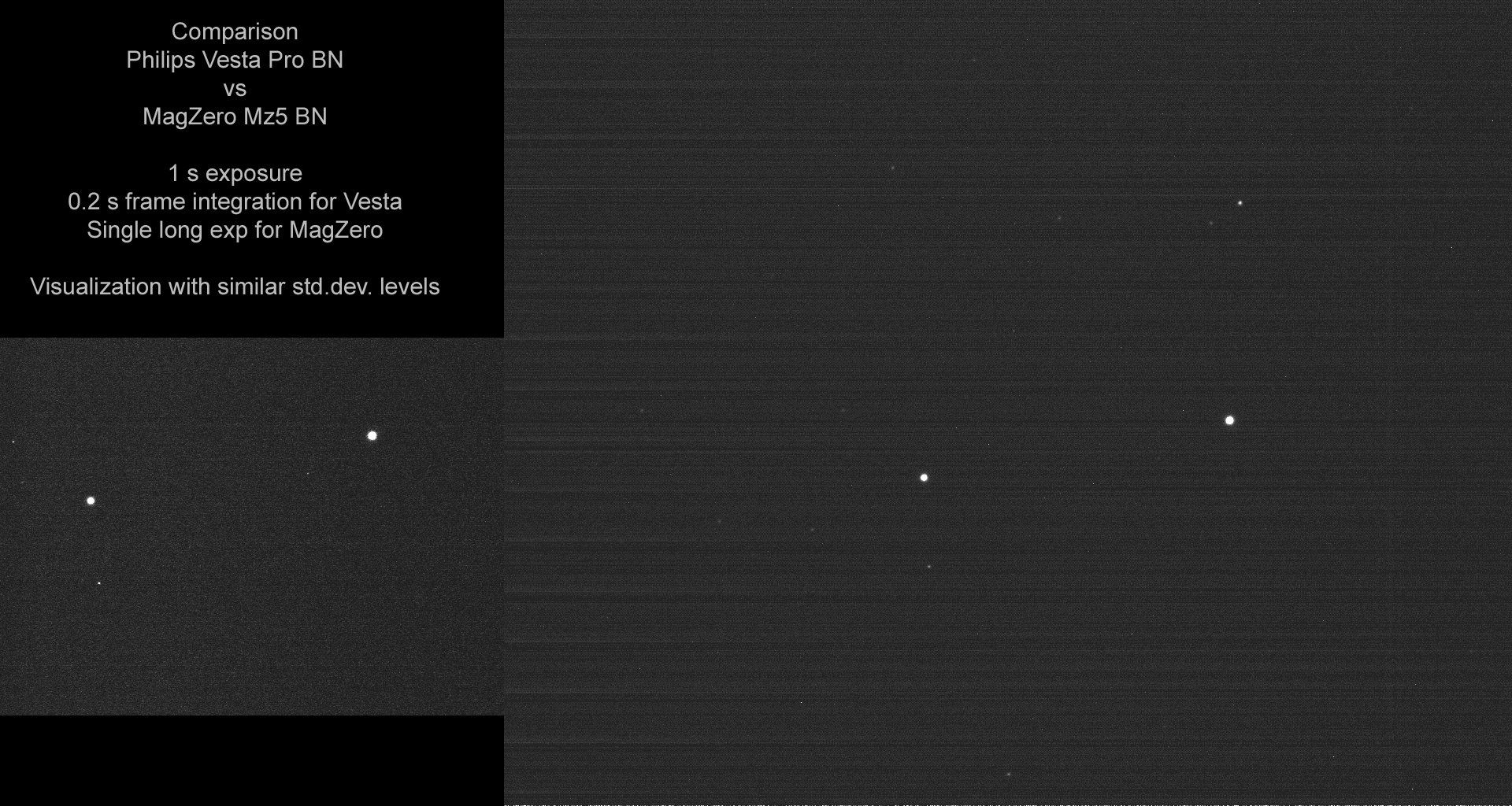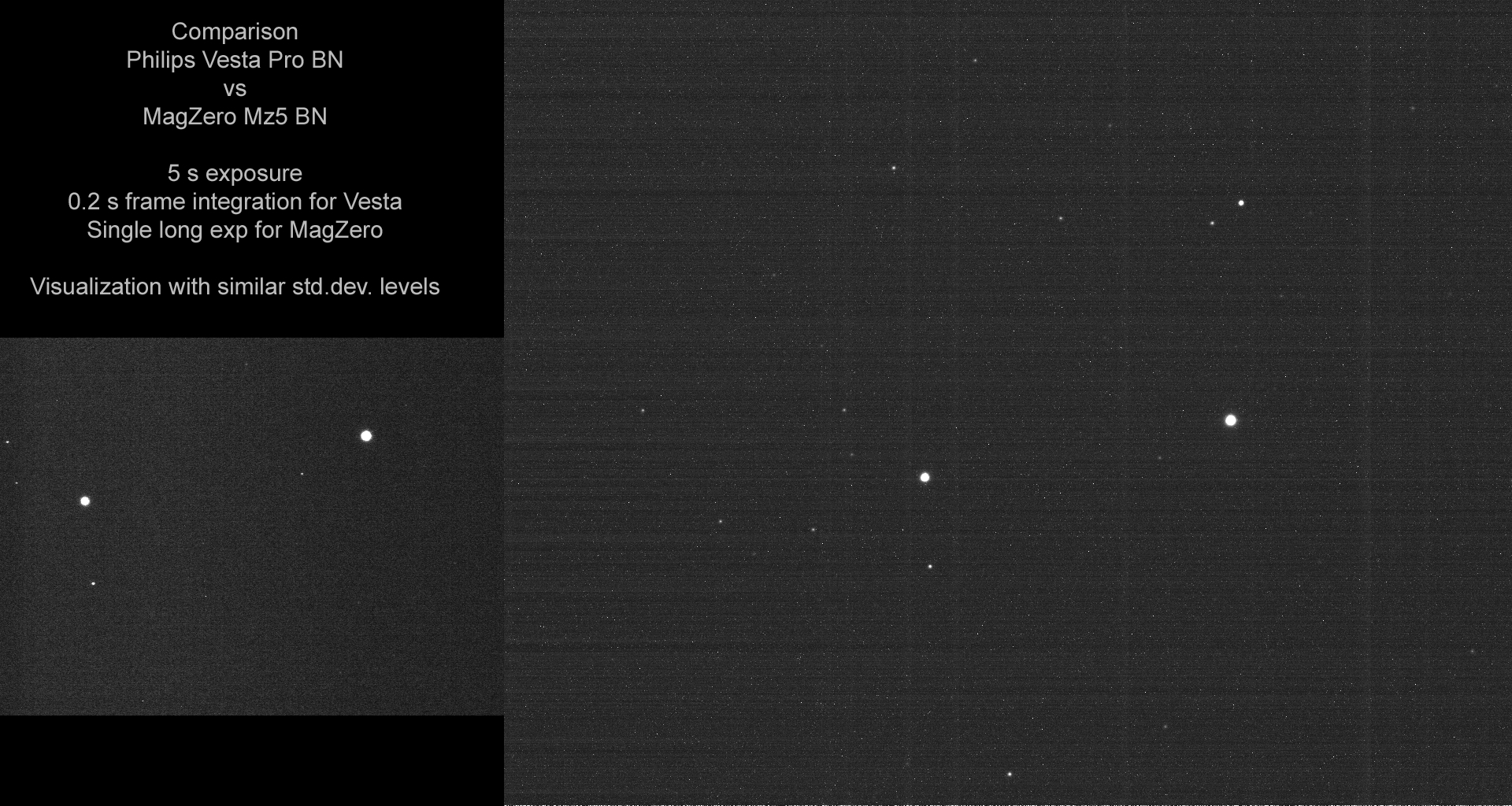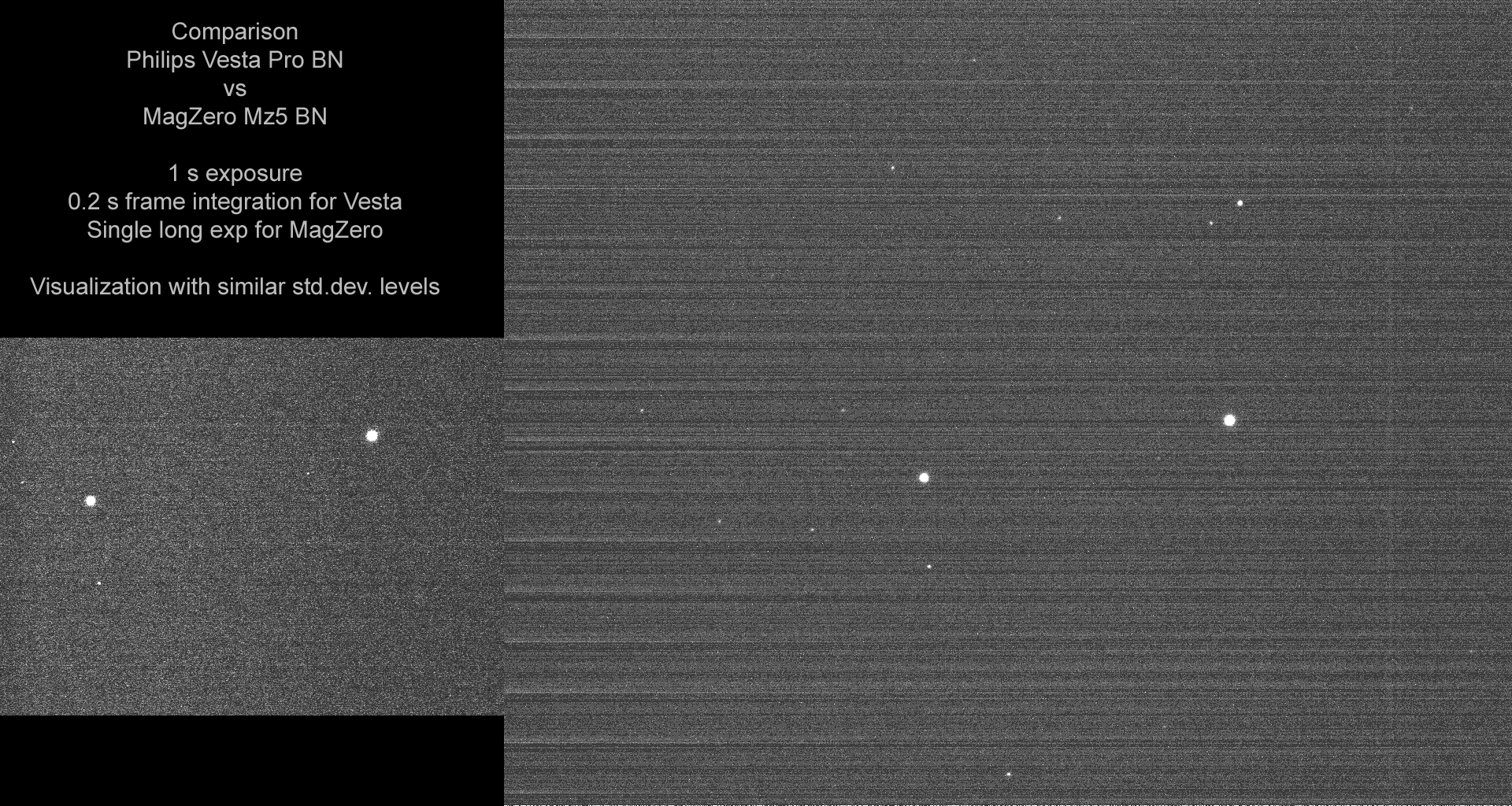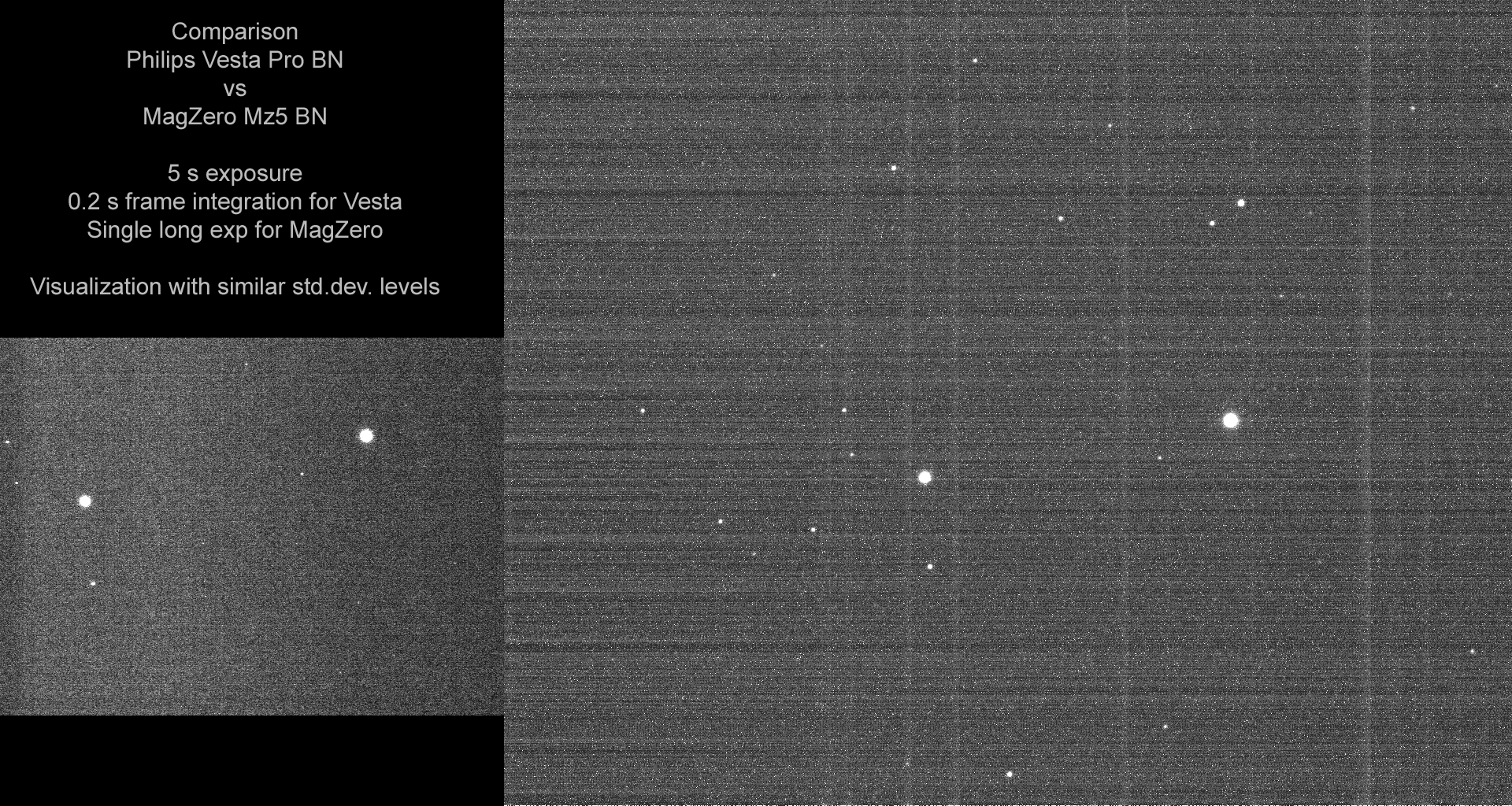This post is also available in: Italiano (Italian)
by Emmanuele Sordini and Lorenzo Comolli
The MagZero MZ-5m camera, the Italian flavor of the QHY5 CCD guider, has been around for quite a while, and has ever since been quite popular among amateur astronomers as a good bang for the buck. This camera has already been reviewed on bloomingstars.com: back then, we highlighted its streghts, such as its lightweight as ease of use (thanks to the built-in ST4 compatible interface; this time, we do a side-by-side comparison of sensitivity and noise with an old veteran of imaging and autoguiding: the Philips Vesta Pro webcam.
Lorenzo Comolli and I met at his Observatory to do a side-by-side test between the MZ-5m and a veteran of hi-res imaging, the Philips Vesta Pro. which came with a B/W sensor (in place of the standard Bayer-matrix color version) and an enhanced firmware version that allows for raw mode acquisition. This features boost the camera’s sensitivity, thereby making it suitable for hi-res imaging and autoguiding.
First off, we can arrange both cameras’ specs into a comparative table which will come in handy later on:
| Camera | Pixel size (microns) | Pixel res. (h x v) | Detector size (mm) | Detector type |
|---|---|---|---|---|
| Magzero MZ-5m | 5.2 x 5.2 | 1280 x 1024 | 6.66 x 5.32 | CMOS |
| Philips Vestra Pro B/W | 5.6 x 5.6 | 640 x 480 | 3.58 x 2.50 | CCD |
The above table clearly shows the MZ-5m has got a unquestionable edge over the Vesta Pro as far as pixel number and detector size are concerned.
Camera shootout
The camera shootout was performed on March 2, 2008, on a crystal clear night with a temperature around 10 °C. A strong and dry foehn wind had been sweeping the sourrounding areas all day long. We used Lorenzo’s 75-mm (500-mm FL) Pentax refractor, riiding piggyback on a 310 mm f/5 Newtonian Reflector, which in turns is mounted alongside a Schmidt Camera. All images were taken on the very same region of the sky, to allow for easier comparison. Here’s the exposure list:
- Philips Vesta Pro, 1 s exp. time (sum of 5 0.2-s subexposures)
- Philips Vesta Pro, 5 s exp. time (sum of 25 0.2-s subexposures)
- Magzero MZ-5m, 1 s exp. time (single exposure)
- Magzero MZ-5m, 5 s exp. time (single exposure)
We can now arrange these pictures in pairs, to make side-by-side comparisons of the two cameras, all other factors being equal. The resulting composites can be found below: clicking on any one of them will bring up a pop-up window with a higher resolution version (Warning: a minimum screen resolution of 1280 x 1024 pixels is needed). As an alternative, for the maximum possible resolution the pictures can be saved and viiewed locally at full resolution (1920 x 1024 pixels).
We present the images below in two “flavors”, which came out by applying different screen stretch ranges to them. Let μ be the average intensity value (ADU), and σ its standard deviation. We used the following two different stretch ranges:
- A. Stretch range: [μ – 5 σ, μ + 25 σ];
- B. Stretch range: [μ – 3 σ, μ + 6 σ].
As we can imagine, B-type stretching is very unforgiving of camera defects, and can be fruitfully used for diagnostic purposes.




If anybody wants to play around with the original FITS from which we made the composites, they can be found here.
From the above images, which we also analyzed quantitatively with Maxim DL, at least a couple of interesting conclusions can be drawn:
- With the same exposure time, there is no clear winner in pure sensitivity (The Magzero having perhaps a teeny-weeny edge over the Vesta Pro in this respect, since we took one single long esposure wth the former instead of adding many short ones together);
- With the same exposure time, the image taken with the Magzero looks noisier and, even worse, strewn with horizontal and vertical bands and many hot pixels. The higher the gain, the worse the disturbances.
In our test we used the latest version of the camera driver (2.6), which – according to the manufacturer’s claims – was supposed to get rid of this problem by using an ad-hoc noise reduction feature (“ENR”). We can attest to the noise reduction presence, since upon deactivating it, we could barely tell single guidestars from the background mess! We may concede that this NR feature certainly works, and that the autoguiding performance doesn’t seem to be hampered by this phenomenon either. However, we wonder if there should be any such flaws at all in an astronomical camera.
There are two possible ways of keeping hot pixels at bay:
- Using Magzero’s built-in hot pixel reduction feature, which is most likely based on a low-pass kernel filter (e.g. 3 x 3 pixels). This takes many hot pixels out, but at the expense of image sharpness.
- Automatic dark frame subtraction. On the whole this method yields better results than the former, but it’s also much more of a hassle. The dark frame has to be taken manually since there’s no mechanical shutter, and as many times as needed during an observing session to adjust to temperature variations.
As for pure autoguiding performance in itself, we took several 5-minute exposures with a FLI ME2 CCD camera at the prime focus of Lorenzo’s Newtonian telescope (1260 mm FL). Both cameras did quite well, especially taking into account the guidescope’s focal length (which is considerably shorter than that of the imaging instrument) and the unfavorable weather conditions (wind gusts and bad seeing).
Conclusion
So, $1M-question: is there any clear winner here? Short answer: nope, it depends on which feature we are most interested in.
- Pixel size: tie
- Background noise/hot pixels: Vesta Pro
- Detector size: Magzero MZ-5m
- Built-in ST-4 port: Magzero MZ-5m.
So bottom line is, that if we look at the ease of use in itself, then the MZ-5m wins. But it is also much of a disappointment when it comes to comparing the background noise and the amount of hot pixels: the Vesta Pro is the clear, hands-down winner here, especially if we take into account that the two cameras were designed five or six years apart, which means ages in the world of digital imaging. One could argue that the Vesta Pro has got a CCD detector whereas the Magzero has a CMOS one (see table at the beginning of this article). A very weak point indeed: just think of the outstanding performance of CMOS-equipped Canon DSLRs versus their Nikon counterparts, which have almost only had CCD sensors.
We can’t really help but point out Magzero’s dismal performance in this respect: in our opinion, it proved to be suitable for autoguiding but not so for either planetary or deep-sky imaging, in spite of the high S/N ratio of the solar system bodies, because not even a good dark frame is sufficient to get rid of the horizontla banding. And we also wonder if that many frame flaws (hot pixels in particular) could ever undermine its autoguiding performances, especially with the higher temperatures normally experienced in the warmer season. The exposures made on the very same night turned out OK, but we will make no early judgments without any further testing. In the meantime, just pay attention not to pick out too feeble a guidestar, use the camera’s gain control sparingly, and always strive for the best image clearness/sensitivity tradeoff.
